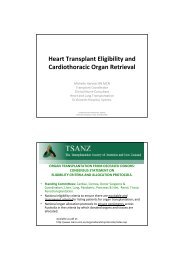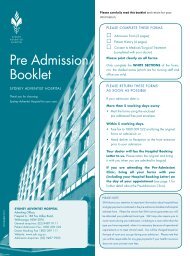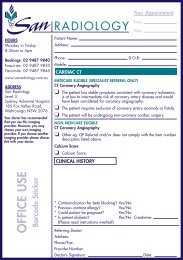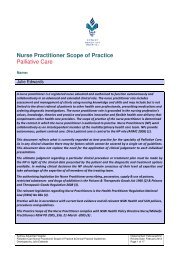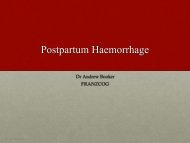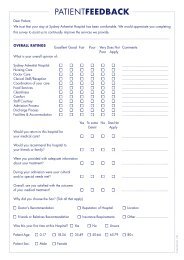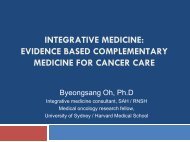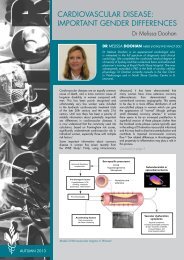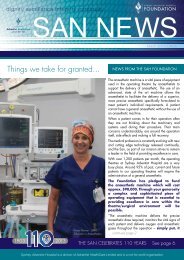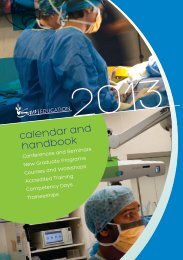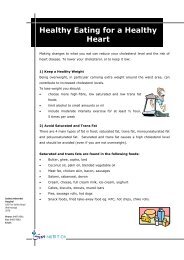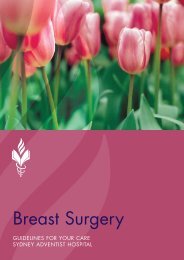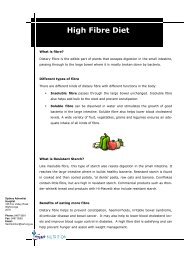Oesophagectomy - Dr Stephanie Phillips - Sydney Adventist Hospital
Oesophagectomy - Dr Stephanie Phillips - Sydney Adventist Hospital
Oesophagectomy - Dr Stephanie Phillips - Sydney Adventist Hospital
You also want an ePaper? Increase the reach of your titles
YUMPU automatically turns print PDFs into web optimized ePapers that Google loves.
Upper Gastrointestinal Seminar-2012<br />
Anaesthesia for <strong>Oesophagectomy</strong><br />
<strong>Dr</strong> <strong>Stephanie</strong> <strong>Phillips</strong> BMed, DA, FRCA, FANZCA<br />
Specialist Anaesthetist, <strong>Sydney</strong> <strong>Adventist</strong> <strong>Hospital</strong><br />
Senior Lecturer, <strong>Sydney</strong> Medical School
Anaesthesia for <strong>Oesophagectomy</strong><br />
Levels of evidence<br />
2
Anaesthesia for <strong>Oesophagectomy</strong><br />
› Anaesthetic Preparation<br />
› Intra-operative anaesthetic management<br />
› Postoperative management<br />
› Risks<br />
3
Anaesthesia for <strong>Oesophagectomy</strong><br />
Anaesthetic Preparation<br />
Preadmission Clinic<br />
› RN<br />
› Anaesthetist<br />
› Physiotherapist<br />
› Case manager<br />
› Preoperative investigations<br />
4
Anaesthesia for <strong>Oesophagectomy</strong><br />
Anaesthetic Consultation<br />
› History<br />
› Examination<br />
- Airway<br />
- Venous access<br />
- Analgesia<br />
Information & risk discussion<br />
Order & review investigations<br />
Premedication & preparation<br />
Medications: anti-platelet, B Blockers, statins, ACE inhibitors,<br />
Premedication: GABA analogues, anxiolytics, DVT prophylaxis, PPI<br />
Fasting<br />
5
Anaesthesia for <strong>Oesophagectomy</strong><br />
Intra-operative anaesthetic management<br />
- Preparation<br />
- Time out<br />
- Venous access<br />
- Lung isolation<br />
- Positioning<br />
- Monitoring<br />
- Temperature<br />
- Fluids<br />
- Nasogastric tube<br />
6
Anaesthesia for <strong>Oesophagectomy</strong><br />
Venous Access<br />
› Peripheral<br />
› Central<br />
- Porta catheter access<br />
- Percutaneous<br />
- Subclavian<br />
- Internal Jugular<br />
Suture for nasogastric tube<br />
7
Anaesthesia for <strong>Oesophagectomy</strong><br />
Tracheal Intubation<br />
positive pressure ventilation<br />
deflate right lung for surgical access<br />
› Double lumen tracheal tube or bronchial blocker<br />
Nasogastric tube<br />
8
Positioning of the double lumen tracheal tube<br />
Anaesthesia for <strong>Oesophagectomy</strong><br />
Testing the position of the DLT.<br />
Bronchoscopic view of DLT<br />
9
Anaesthesia for <strong>Oesophagectomy</strong><br />
Positioning and patient care<br />
› Prep for case taking 6 hours<br />
- Maintain normothermia<br />
- Infection<br />
- Bleeding<br />
- Hypoxia on shivering<br />
- Abnormal drug metabolism<br />
- Positioning<br />
- Laparotomy and right thoracotomy<br />
- Prevent neuropathy, corneal damage<br />
- Potential for blood loss<br />
- IV fluid management<br />
- Nasogastric low suction<br />
10
Anaesthesia for <strong>Oesophagectomy</strong><br />
MONITORING<br />
› SpO 2<br />
› ECG<br />
› Intra-arterial blood pressure<br />
› Central venous pressure<br />
› Temperature<br />
› Entropy<br />
› Neuromuscular function<br />
› Inspired & expired O 2 & CO 2 , anaesthetic agents<br />
› Airway pressures & volumes<br />
› Urine output<br />
› Blood loss<br />
11
Anaesthesia for <strong>Oesophagectomy</strong><br />
End of stage 1<br />
<strong>Dr</strong>ain<br />
Wound catheters<br />
Jejunostomy<br />
12
Anaesthesia for <strong>Oesophagectomy</strong><br />
Positioning for Right thoracotomy<br />
13
Anaesthesia for <strong>Oesophagectomy</strong><br />
One Lung Anaesthesia<br />
14
Anaesthesia for <strong>Oesophagectomy</strong><br />
Oesophago-gastrectomy<br />
Pull back ng tube<br />
Test anastomosis<br />
15
Anaesthesia for <strong>Oesophagectomy</strong><br />
End of stage 2<br />
Prepare for extubation:<br />
General condition (blood loss,<br />
temp etc)<br />
2 under water seal pleural drains<br />
Para-vertebral catheter<br />
Analgesia-top up epidural<br />
Reversal<br />
Extubation- if fails re-intubation<br />
with a single lumen tracheal tube<br />
Transfer to ICU<br />
16
Anaesthesia for <strong>Oesophagectomy</strong><br />
Intensive Care Management<br />
› Excellent analgesia<br />
› Physiotherapy- chest and mobilisation<br />
› Nutrition<br />
› Avoid DVT<br />
› Careful haemodynamic management<br />
- Too much fluid- pulmonary oedema<br />
- Too little ischaemia of oesophagus<br />
IPPV?<br />
17
Anaesthesia for <strong>Oesophagectomy</strong><br />
Excellent Multi-modal Analgesia<br />
› Epidural Anesthesia<br />
› Para vertebral<br />
› Intra-pleural<br />
› Pre-peritoneal<br />
› Patient Controlled Intravenous or Epidural<br />
› Local anaesthetics +low dose opioids<br />
› Epidural Opioids<br />
› Paracetamol<br />
› NSAIDS<br />
› GABA analogues<br />
› Tramadol<br />
18
Anaesthesia for <strong>Oesophagectomy</strong><br />
Thoracic Epidural Analgesia<br />
Local anaesthetic + opioid<br />
PCEA + wound infusions<br />
19
Post operative Complications<br />
Pulmonary-<br />
Collapse/consolidation<br />
Infection<br />
Oedema<br />
Anaesthesia for <strong>Oesophagectomy</strong><br />
Surgical:<br />
Confusion<br />
Infection:<br />
DVT<br />
Haemorrhage<br />
Anastomotic leak<br />
Chyle leak<br />
Wound<br />
Line<br />
Urinary catheter<br />
Pulmonary Embolus<br />
Malnutrition<br />
20
Anaesthesia for <strong>Oesophagectomy</strong><br />
Pulmonary Complications -25%<br />
10-20% ARDS<br />
50% mortality<br />
Causes:<br />
Preop-smoking<br />
Pulmonary fibrosis<br />
Intra-operative hypoxia<br />
One lung ventilation time<br />
Fluid overload<br />
Prevention<br />
Physio<br />
Fluid Balance<br />
Mobilisation<br />
Humidifcation<br />
21
Anaesthesia for <strong>Oesophagectomy</strong><br />
Anastomotic leak 10-15%<br />
- Gastric tube ischaemia<br />
- Hypotension<br />
• Epidural<br />
• Vasoconstrictors<br />
- Surgical tension<br />
22
Anaesthesia for <strong>Oesophagectomy</strong><br />
Cardiovascular<br />
- AMI (24% in thoracotomy)<br />
- Dysrhythmias-60%<br />
23
Anaesthesia for <strong>Oesophagectomy</strong><br />
RISK<br />
› Patient-<br />
- Co-morbidities<br />
- Body habitus<br />
- Nutritional status<br />
- Immunological status<br />
› Anaesthetic<br />
› Surgery<br />
24
RISK-Very common 1 in 2 -10<br />
Anaesthesia for oesophagectomy<br />
1:2 -heads or tails<br />
- Pain- severe after major surgery.<br />
- Sore throat 1in 2 after intubation, more with double lumen tube & ng<br />
1:4<br />
-Cognitive dysfunction at 1 week<br />
1:6 -rolling a 6 on a dice<br />
-backache<br />
25
Anaesthesia for <strong>Oesophagectomy</strong><br />
RISK-Common 1 in 10- 99<br />
1:10- 3 balls in Lotto<br />
Thrombophlebitis<br />
Cognitive dysfunction at 3 months (>60)<br />
1:20- 2 pairs in poker<br />
All oral trauma after intubation more with DLT<br />
1:35 rolling a double 6<br />
Accidental puncture of carotid artery on jugular cannulation<br />
26
Anaesthesia for <strong>Oesophagectomy</strong><br />
RISK-Moderately common 1 in 100-999<br />
1:100-dying of any cause in the next year!<br />
Permanent cognitive dysfunction (>60)<br />
Permanent damage from arterial cannulation<br />
1:200<br />
Arterial puncture of subclavian artery<br />
Perioperative death at 1 month- all patients<br />
1:500– flush in poker<br />
Awareness<br />
27
Anaesthesia for <strong>Oesophagectomy</strong><br />
RISK-Less common 1:1000-9999<br />
1:1000 Corneal abrasion<br />
Neuropathy<br />
1:1500 Local anaesthetic toxicity<br />
1:2000 Permanent neuropathy after epidural<br />
1:3000 Painful awareness<br />
1:5000 Epidural abscess (spontaneous epidural abscess 1:10000)<br />
Death related to anaesthesia ASA3-4<br />
28
Anaesthesia for <strong>Oesophagectomy</strong><br />
RISK-rare 1:10,000 – 99 999 (accidental death at home 1:11,000)<br />
1:10,000<br />
Anaphylaxis<br />
Systemic LA toxicity<br />
1:100,000<br />
Paraplegia due to epidural<br />
Death related to anaesthesia-ASA 1-2<br />
royal straight flush<br />
1:10,000,000 Lightening strike<br />
29
Morbidity & Mortality<br />
Anaesthesia for <strong>Oesophagectomy</strong><br />
›In hospital mortality-5% (cardiac
Anaesthesia for <strong>Oesophagectomy</strong><br />
Level 4 evidence: expert opinion<br />
‘X’- an unknown quantity<br />
“spurt”- a drip under pressure<br />
31



